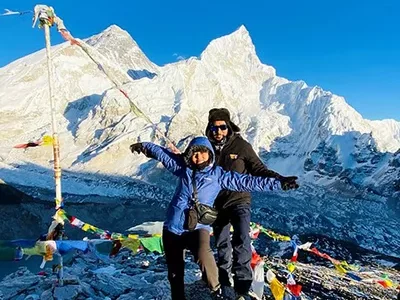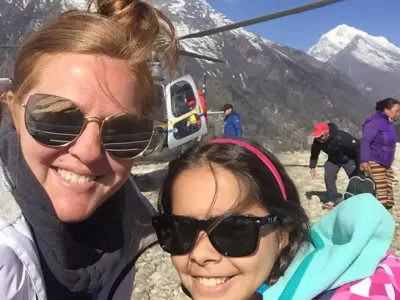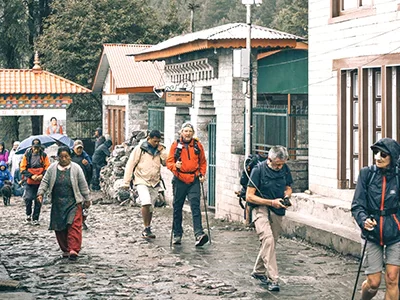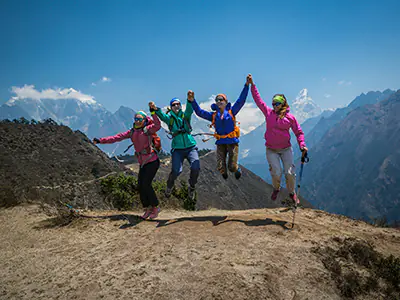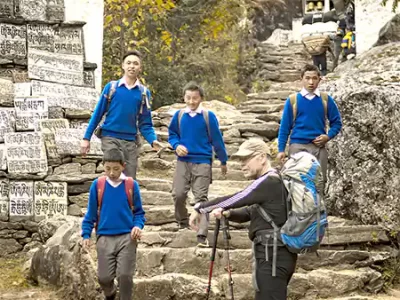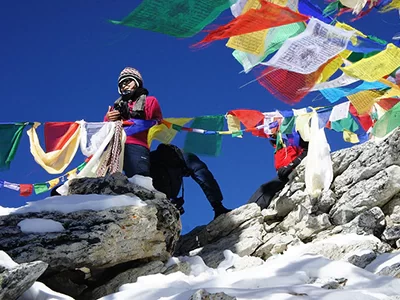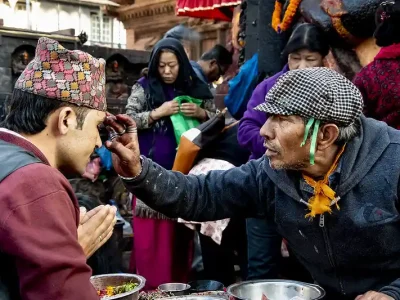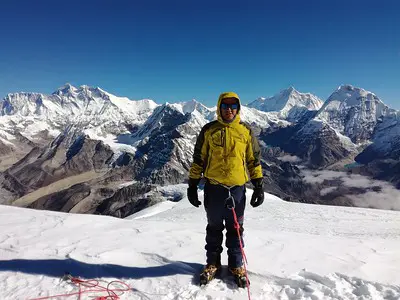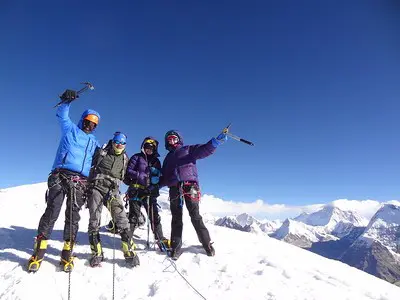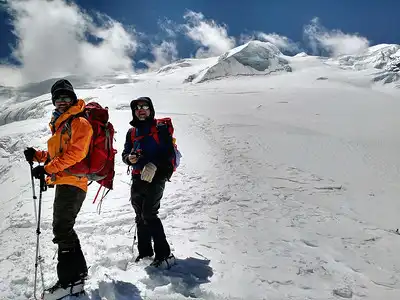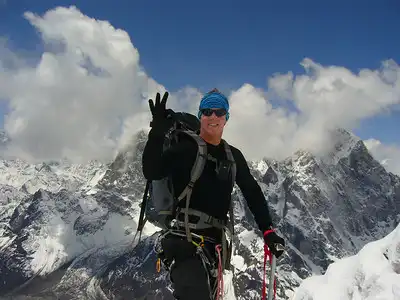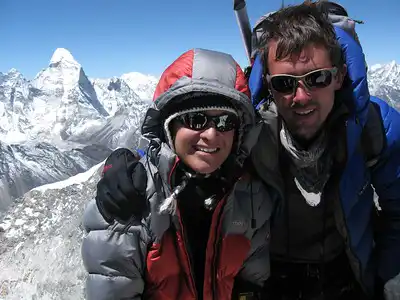Nestled amidst the breathtaking Himalayas, Gorakshep welcomes adventurers and trekkers with open arms. This small settlement, perched at a remarkable height, isn’t just a stopover. It’s a crucial stepping stone on the thrilling trek to Everest Base Camp.
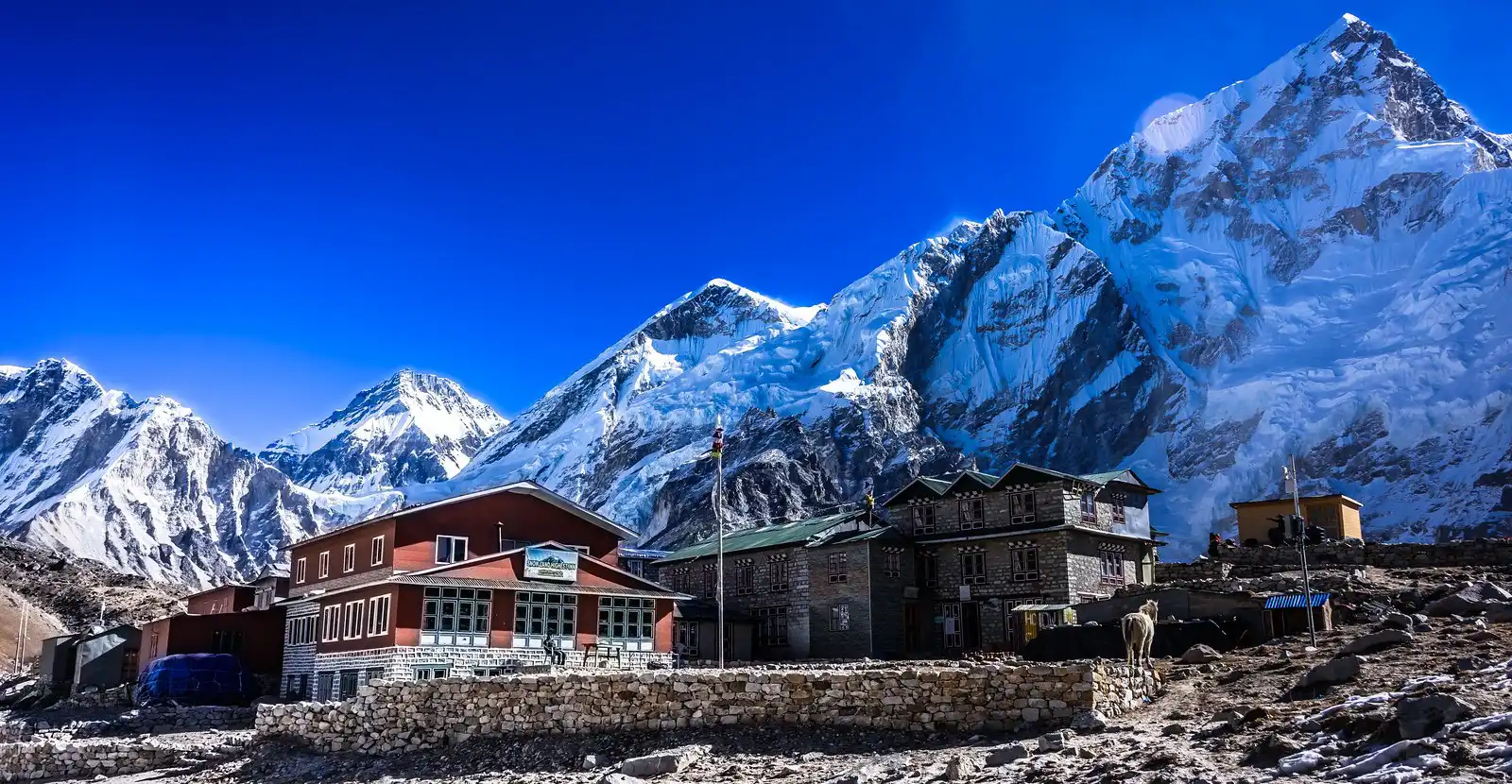
Gorakshep’s magic lies in its closeness to the world’s highest peak and its role as a high-altitude haven. Here, trekkers can adapt to the thin air, reducing the risk of altitude sickness before their final push to Base Camp and the exhilarating climb to Kala Patthar.
Where Gorakshep Stands and Why It Matters
Gorakshep holds a unique place in the Everest region, making it an essential part of any trekking adventure:
- Surrounded by Giants: Located at the head of the Khumbu Valley, Gorakshep treats you to awe-inspiring views of iconic peaks like Everest, Nuptse, and Lhotse.
- Your Body’s Adjustment Zone: At a staggering 5,164 meters (16,942 feet), Gorakshep’s high altitude helps you acclimate, preparing you for the even thinner air at Everest Base Camp.
- The Gateway to Everest Base Camp: Just a short 3.5-kilometer (2.2-mile) trek separates you from Everest Base Camp, making Gorakshep the perfect final overnight stop before reaching the base of the world’s tallest mountain.
- Your Starting Point for Kala Patthar: The trail to Kala Patthar, famous for its breathtaking sunrise and sunset views of Everest, starts here in Gorakshep. This 1.5-kilometer (0.9-mile) hike is a must-do for most trekkers.
- A Welcoming Rest Stop: Gorakshep sits conveniently on the main Everest Base Camp trekking route. Whether coming from Lobuche (5 kilometers or 3.1 miles away) or heading towards Base Camp, it’s the perfect place to rest and recharge.
Everest Base Camp Trek
Everest Base Camp Trek with Helicopter Return
Luxury Everest Base Camp Trek
Gorakshep: Where the Sky Meets the Earth
Gorakshep isn’t just a dot on a map. It’s a living testament to our planet’s raw power and breathtaking beauty. This village, nestled amidst the towering peaks of the Himalayas, holds a special place in the hearts of those who dare to trek its high-altitude trails.
Shaped by Nature’s Hand
Gorakshep rests at the head of the Khumbu Valley, sculpted over millennia by the relentless Khumbu Glacier. The village stands on a moraine, a rocky reminder of the glacier’s slow retreat. Imagine being surrounded by some of the world’s most majestic mountains, Everest, Nuptse, and Lhotse, a panorama few are lucky to witness.
Altitude: A Challenge and a Reward
The village’s location at a breathtaking 5,164 meters (16,942 feet) above sea level is a defining feature. This extreme altitude creates a unique experience for trekkers:
- Breathing Thin Air: The air up here is noticeably thinner, with far less oxygen than at sea level—the symptoms of altitude sickness range from headaches and nausea to more severe conditions.
- Acclimatization is Your Friend: Spending time in Gorakshep aids your body’s acclimatization to the lower oxygen levels at higher altitudes. This process, called acclimatization, is vital for a safe and enjoyable trek.
- Every Step Counts: Even simple tasks can be more demanding at high altitudes. Pace yourself and pay attention to how your body feels.
- Embrace the Cold: Temperatures can plummet, especially at night. Pack warm layers and a cozy sleeping bag to stay comfortable.
- Views Beyond Compare: The reward for reaching such heights? Scenery that will leave you speechless. Gorakshep offers an unobstructed view of the Himalayas’ grandeur.
Gorakshep weather: Preparing for the High-Altitude Climate
Gorakshep stands tall at a remarkable elevation, where the Gorak shep weather patterns can be as dramatic as the surrounding Himalayan landscape. Understanding these conditions is crucial for any trekker venturing to this high-altitude haven.
Year-Round Temperatures
- Summer (June-August): Days are relatively mild, with temperatures reaching around ten °C (50°F) highs. However, nights remain cold, often dipping below freezing. Expect occasional rain showers and even snow at higher elevations.
- Autumn (September-November): This is considered the peak trekking season due to clear skies and stable weather. Daytime temperatures hover between 5-15°C (41-59°F), while nights get significantly colder, averaging around -5°C (23°F).
- Winter (December-February): Gorakshep experiences harsh winter conditions with heavy snowfall and temperatures plunging well below freezing, often reaching -15°C (5°F) or colder. Trekking during this season is challenging and requires specialized gear.
- Spring (March-May): The weather gradually increases as the snow melts. Daytime temperatures range from a chilly 0 to 10°C (32-50°F), but nights are consistently cold. Autumn is also famous for trekking, offering clear views and pleasant conditions.
Seasonal Variations & Their Impact on Trekking
- Monsoon Season (June-August): The monsoon brings heavy rainfall to lower altitudes, but Gorakshep, located in the rain shadow of the Himalayas, experiences less precipitation. However, slippery trails and reduced visibility might affect the area.
- Winter Season (December-February): The extreme cold and heavy snowfall make trekking challenging and potentially dangerous. Only experienced trekkers with appropriate gear and knowledge should attempt winter treks.
- Shoulder Seasons (Spring & Autumn): These are the ideal times to trek to Gorakshep. The weather is typically stable, characterized by clear skies and comfortable temperatures, creating perfect conditions for trekking.
Everest Base Camp Trek for Beginners
Everest Panorama Trek
Everest High Pass Trek
Gorakshep Trekking Routes: Navigating the Himalayan Trails
Gorakshep is a pivotal point on the Everest Base Camp trek, offering access to iconic destinations like Everest Base Camp and Kala Patthar. Understanding the trekking routes to and from Gorakshep helps trekkers prepare for the challenges and rewards that await.
Gorakshep to Everest Base Camp
- Distance: The trek from Gorakshep to Everest Base Camp covers approximately 3.5 kilometers (2.2 miles).
- Terrain: The trail is relatively flat but rocky, winding through the Khumbu Glacier moraine.
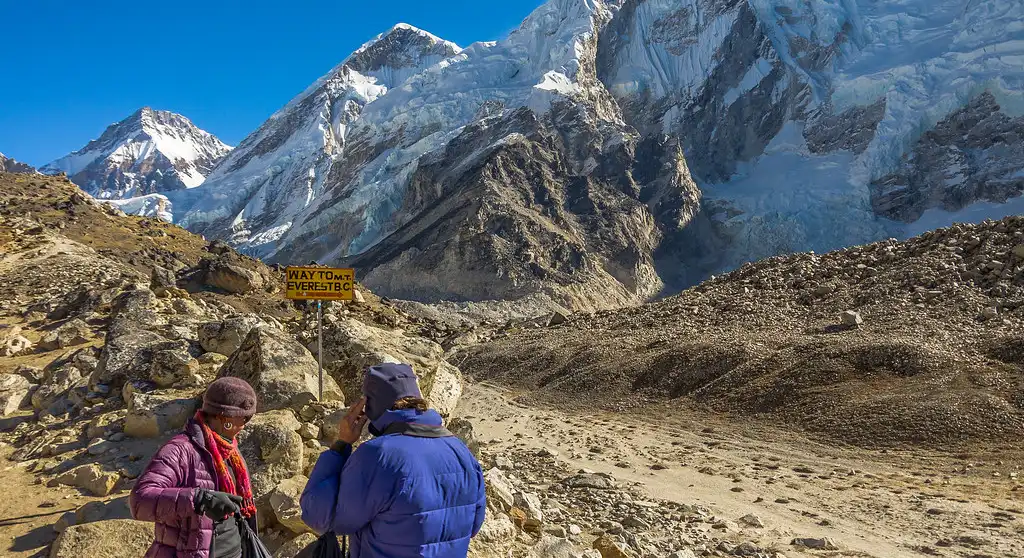
The high altitude and thin air can make the trek more challenging than the distance suggests.
- What to Expect: Trekkers will encounter stunning views of the Khumbu Icefall and the surrounding peaks. The trail passes through the Everest Base Camp area, where colorful tents and prayer flags appear. Be prepared for crowds, especially during peak seasons.
Gorakshep to Kala Patthar
- Distance: The hike to Kala Patthar is about 1.5 kilometers (0.9 miles) from Gorakshep.
- Terrain: The trail is steep and rocky, gaining significant elevation. The thin air at this altitude makes the climb demanding.
- Views: Kala Patthar, at 5,643 meters (18,514 ft), offers arguably the best views of Mount Everest. Witnessing the sunrise or sunset over the world’s highest peak is an unforgettable experience.
Lobuche to Gorakshep
- Distance: The trek from Lobuche to Gorakshep covers approximately 5 kilometers (3.1 miles).
- Terrain: The trail is generally well-defined but involves a gradual ascent with some rocky sections.
- Key Sights: Trekkers will pass through the memorial area dedicated to climbers who died on Everest. The trail also offers glimpses of the Khumbu Glacier and surrounding peaks.
- Challenges: The altitude gain and potential for strong winds can make this section challenging.
Rest and Recharge in Gorakshep: Your High-Altitude Haven
Though nestled deep within the Himalayas, Gorakshep offers surprisingly diverse places to stay, catering to all budgets and needs. Knowing what awaits helps you plan a comfortable stay in this remarkable high-altitude village.
Where to Rest Your Head
- Tea Houses and Lodges: This is the most popular choice.
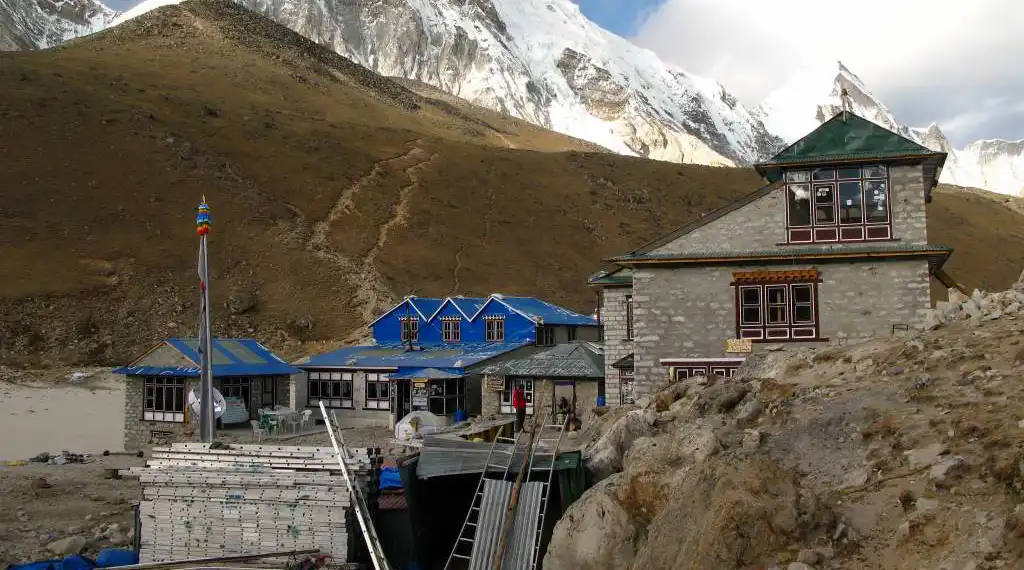
These family-run spots offer simple rooms, usually with shared bathrooms. Some might have a few private rooms, but they’re in high demand.
- Guesthouses: Similar to tea houses but often with slightly cozier rooms and a few more amenities.
- Camping: It’s possible but less common here due to the chilly temperatures and limited flat ground.
What to Expect
- Food: Tea houses and guesthouses serve up tasty meals, usually a mix of Nepali and Tibetan dishes like dal bhat (rice and lentil stew), momos (dumplings), and thukpa (noodle soup). You might find some Western options, but the selection could be limited.
- Internet: Some places have Wi-Fi, but it’s okay if it’s slow or spotty due to their remote location.
- Charging Up: Most places let you charge your devices, but there might be a small fee.
- Medical Help: The village has a primary health post for minor issues. For anything serious, you should go to a lower altitude.
Tips for Finding the Perfect Place
- Book Ahead: During peak trekking seasons (spring and autumn), places fill up fast. Book your stay in advance, particularly if you’re after a private room.
- Budget Wisely: Prices vary based on the accommodation type and time of year. Tea houses are usually the most budget-friendly, while guesthouses and private rooms cost a bit more.
- Stay Warm and Cozy: Look for places with comfy beds, warm blankets, and heating, as nights can get very cold.
- Check the Buzz: Read online reviews or chat with other trekkers for recommendations before choosing.
Here are a Few More Things to Keep in Mind
- Simplicity is Key: Remember, you’re in a remote mountain village. Expect something other than luxury or all the bells and whistles.
- Peak Season Crowds: During popular trekking times, it can get busy. Be patient and respectful of your fellow adventurers.
- Pack Your Essentials: Most places don’t provide toiletries, so bring soap, shampoo, etc.
- Cash is King: Credit cards are only sometimes widely accepted here. Bring enough cash to cover your stay.
Staying Safe and Healthy at High Altitude
Trekking to this Himalayan village is an incredible experience, but remember, it’s at a seriously high altitude. Take care of yourself up there and have a unique, unforgettable adventure.
Altitude Sickness: Know the Warning Signs
Altitude sickness can sneak up on anyone trekking at high elevations like Gorakshep, which is 5,164 meters (16,942 feet). At the high elevation of Gorakshep, which is 5,164 meters (16,942 feet), altitude sickness can sneak up on anyone trekking in the area, highlighting the importance of understanding Gorakshep elevation. Watch out for these symptoms:
- Pounding headache
- Feeling sick to your stomach or throwing up
- Feeling dizzy or lightheaded
- Unexplained tiredness
- Struggling to catch your breath
Prevention is Key
- Take it Slow: Ascend gradually, giving your body time to adjust to the thinner air.
- Hydrate, Hydrate, Hydrate: Drink plenty of water. Skip the alcohol and too much caffeine. They’ll dehydrate you faster.
- Fuel Your Body Right: Eat plenty of carbs for energy and avoid heavy meals that are hard to digest.
- Listen to Your Body: If you’re not feeling well, rest. Don’t push yourself beyond your limits.
- Consider Medication: Talk to your doctor about medicines to help prevent altitude sickness.
Beyond Altitude: More Health Tips
- Sun Protection is a Must: The sun’s rays are more potent at high altitudes. Shield your skin and eyes from the sun by consistently wearing sunscreen, sunglasses, and a hat.
- Bundle Up: Temperatures can drop like a rock, especially at night. Pack warm layers, a good down jacket, gloves, and a warm hat.
- Happy Feet, Happy Trek: Wear comfy, well-worn hiking boots and moisture-wicking socks to prevent blisters.
- Stay Clean: Good hygiene keeps you healthy. Wash your hands often and carry hand sanitizer.
- Get Insured: Get travel insurance that covers high-altitude trekking and emergency evacuation, just in case.
Extra Tips for a Safe Trek
- Trek with Pros: Choose a reputable trekking company with experienced guides who know how to handle altitude sickness and can help if needed.
- Be Prepared: Pack a basic first-aid kit with essentials like pain relievers, anti-diarrhea medication, and blister treatment.
- Stay in the Know: Check weather forecasts and trail conditions before you head out each day.
Gorakshep: A Photographer’s Dream Come True in the Himalayas
Gorakshep is more than a pit stop on the way to Everest Base Camp; it’s a visual feast where the Himalayas reveal their raw beauty in breathtaking panoramas. Around every corner, unique perspectives await your discovery, and every moment presents itself as a picture-perfect opportunity.
Must-Visit Photo Spots Near Gorakshep
- Kala Patthar: This iconic viewpoint offers unobstructed, awe-inspiring views of Mount Everest, especially at sunrise and sunset.
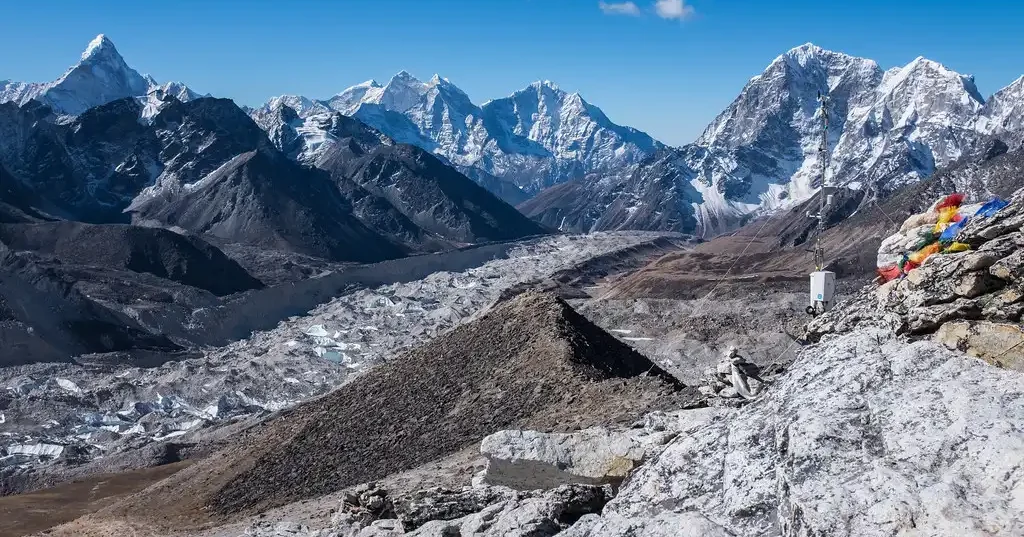
The interplay of light and shadow on the world’s tallest peak is magical. Remember, the hike up from the village is steep, so be prepared for a challenging but rewarding climb.
- Everest Base Camp: Capture the spirit of adventure at Everest Base Camp. Photograph the vibrant tents, prayer flags dancing in the wind, and the sheer immensity of the Khumbu Icefall. During peak seasons, it’s a hive of activity, offering a glimpse into the lives of climbers and Sherpas.
- Gorakshep’s Lakebed: The dried-up lakebed, dotted with tea houses and lodges, makes a unique foreground for framing the surrounding peaks. The contrast between the vast landscape and the small settlement creates a powerful visual story.
- Khumbu Glacier: Experience the raw power of nature as you photograph the massive Khumbu Glacier, a river of ice winding its way through the valley. Focus on capturing the intricate details of the ice formations and the majesty of the surrounding peaks.
- The Milky Way: On clear nights, Gorakshep unveils stunning views of the Milky Way. This celestial spectacle will leave you breathless. Set up your camera for long exposure shots to capture the night sky’s brilliance.
Tips for Capturing Unforgettable Photos
- Pack Smart: Bring only essential camera gear, including a wide-angle lens for sweeping landscapes, a telephoto lens for close-ups of those majestic peaks, and a tripod for stability, especially in low-light conditions.
- Embrace the Weather: Mountain weather is fickle. Be ready for changes and wait for those fleeting moments of clear skies to get the perfect shot.
- Golden Hour is Your Friend: The soft light during sunrise and sunset bathes the mountains in a warm glow. Plan your photo sessions accordingly to capture this magic.
- Add a Human Touch: Include people in your shots to give a sense of scale and bring the landscapes to life.
- Respect Nature: Avoid disturbing the delicate ecosystem. Follow marked trails and respect the environment.
Gorakshep: Preserving Paradise in the Himalayas
High in the mountains, Gorakshep showcases nature’s awe-inspiring power and beauty. But this pristine environment is delicate, and as visitors, we must tread lightly to protect it for future generations.
Environmental Responsibility in the High Himalayas
The challenging altitude and climate make the area around Gorakshep ecologically fragile. Let’s follow these practices to minimize our footprint:
- Pack It Out: Take all your trash, even small things like food wrappers. Dispose of waste responsibly at designated areas in tea houses or villages.
- Stick to the Path: Stay on the marked trails to avoid harming delicate plants.
- Use water Wisely: Water is a precious resource at high altitudes. Use it sparingly for drinking and cleaning up.
- Campfire Care: If you’re camping, use existing fire rings and burn only dead wood. Keep fires small and manageable.
- Observe Wildlife from Afar: Admire animals from a distance and never feed them.
- Support the Locals: Choose eco-conscious lodges and buy local products to help the community thrive sustainably.
Voices from the Trail
Hearing from fellow trekkers adds a personal touch and valuable insights:
- Sarah, a seasoned trekker: “Reaching Kala Patthar was tough, but the views were incredible. The peace of Gorakshep, though, really touched me. It’s a place to connect with nature and appreciate its delicate balance.”
- David, a first-time trekker: “I was nervous about altitude sickness, but taking it slow and drinking lots of water helped a lot. The tea houses in Gorakshep were relieved after a long day of hiking. The friendly atmosphere among trekkers was amazing.”
Conclusion
Gorakshep offers a rare chance to witness the majesty of the Himalayas. By being responsible and respecting the environment, we can ensure that this pristine wilderness remains unspoiled for years. Remember, a successful trek isn’t just about reaching the destination; it’s about protecting the trek for all who follow.

